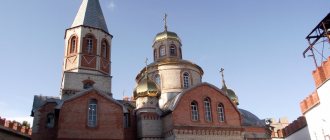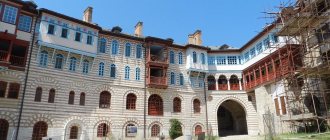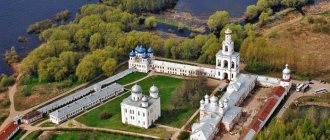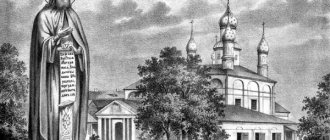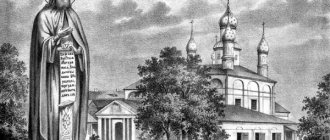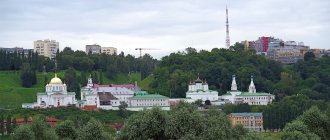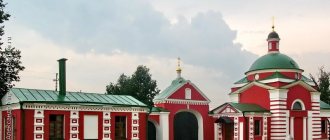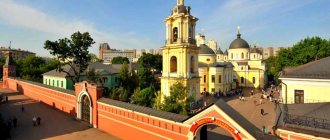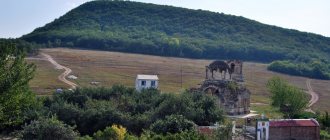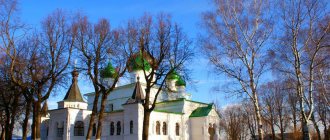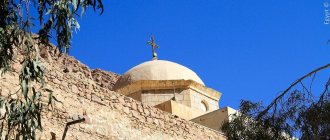Bodbe Monastery or St. Nino in Georgia (Bodbe Monastery of St. Nino, Kakheti, Georgia), located near the city of Sighnaghi in Kakheti, attracts pilgrims from all over the country and the world. After all, it is here that the relics of Nino, who brought Christianity to these lands, the patroness and educator of Georgia, rest. The territory of the monastery deserves special attention - well-groomed green alleys, from which the Alazani Valley is visible, and mountains with snow-capped tops are visible.
Saint Nina
Saint Nina was born into a wealthy family in Cappadocia (present-day Turkish territory). At the age of 12, the girl was given to be raised by a Christian woman serving at the Church of the Holy Sepulchre. She said that the Robe of the Lord was transferred to Iveria (modern Georgia). Two years later, the Mother of God appeared to Nina in a dream, and she told about the election of a girl to search for the Robe and preach the Word of God in that region.
Nino managed to heal the Georgian Queen Nana and King Mirian, her husband, with the help of prayers, after which the ruler accepted Christ. A few years later, in 324, Georgia became Orthodox. The saint went to Kakheti and arrived in the village of Bodbe, where she lived in a tent for several years and converted the Georgians living in the surrounding area to the Christian faith. She died around 335, having bequeathed to bury her in Bodbe, which was done. On the site of her tent in the 50s of the 4th century. They erected a temple (which has not survived to our times), which later grew into a monastery.
According to legend, King Mirian intended to move the relics of the deceased Nino from Bodbe to the Svetitskhoveli Temple in Mtskheta, but two hundred people were unable to move them.
My tourist review
It is clear that the Bodbe Monastery has come a very long way in restoration and now it is pleasant to be in it. The entire territory has been inspected and well-groomed, the buildings are strong and not falling apart, and most importantly, all this does not look like a cheap remake that was needed only in order to use the money allocated by the state, it is clear that they did it primarily for themselves, and therefore soundly and in mind.
My wife and I liked it there, all these trimmed lawns, fir trees, the lack of kitsch - all this was in great contrast with the “home” churches. You could calmly walk along the paths, and no woman at the temple would shush you or look at you from under her brows because you didn’t buy a candle. There are a lot of really young novices there and they don’t hide from tourists, they behave absolutely calm and friendly.
I would love to return here to see what the finished ensemble will look like when the Church of St. Nino.
History of the monastery
The rulers of the royal dynasties always revered this place and showed special concern for its well-being and prosperity. Over time, cultural and religious influences made Bodbe Monastery the center of the Diocese of Bodbe.
Bodbe's heyday was in the 15th century. The monastery became the place of coronation of the Kakheti kings. Afterwards he experienced many different events:
- In the 17th century the Bodbe monastery was destroyed by the Persian ruler Abbas; King Teimuraz I, who restored it, opened a seminary here. The largest number of books on religious topics in Georgia was kept within its walls.
- In the 18th century The monastery of St. Nino became a men's monastery.
- In 1811, after Georgia became part of the Russian Empire, the diocese was abolished, the lands were confiscated, and the place became empty.
- In 1889, Emperor Alexander III, who visited here, was so fascinated by Bodbe that he ordered the restoration of the religious center. The monastery became a women's monastery, and lands were again allocated to it. The buildings of Bodbe were restored, a school of handicrafts and an art school were opened. The first nuns, 12 in number, came here from different parts of Russia. Subsequently, there were about 300 ministers in Bodbe.
- In 1924, the Bolsheviks, who came to power, closed the shrine, abolishing services and destroying buildings, including breaking the cathedral dome. The monastery was abandoned until 1991, when it began to be revived again.
- In 1995 it was decided to renovate the monastery. At this time, archaeological excavations began on the territory of Bodbe, which continue to this day and have revealed valuable relics and parts of ancient buildings.
From 1924 to 1991 There was a hospital in the Bodbe Monastery. One of the most revered icons in Georgia, the Iveron Mother of God icon, was used as a table on which operations took place, as evidenced by the scalpel marks left on it.
History[edit]
According to the Georgian chronicle “Conversion of Kartli”, the construction of the church over the grave of St. Equal-to-the-Apostles Nina dates back to the reign of St. blgv. King Mirian: having founded a nunnery here, the king donated many villages and lands to him.
The royal dynasty of Kakheti and Kartli took special care of the material support and well-being of the monastery. It can be assumed that before the 1230s. Bodbe Monastery remained a significant Christian center in Georgia. From the 1230s to the 15th century information about the monastery has not been preserved, which is due to the Mongol invasions and the severe destruction of both the diocese and the monastery. In the 15th century, with the formation of the independent kingdom of Kakheti, Bodbe regained its former glory as a religious center. However, already in the 16th century. The situation again deteriorated sharply due to Iranian expansion, which led to the abolition of the nunnery.
But the ruling dynasty has always shown special care for Bodbe - kings Levan (1520-1574), Alexander II (1574-1605), Teimuraz I (1606-1616, 1634-1648), Archil II (1664-1675), Teimuraz are known for their care II (1709-1715, 1733-1744, 1744-1762), Irakli II (1744-1762, 1762-1798), George XII (1688-1703), as well as other members of the royal family - Prince Teimuraz, grandson of King Levan, princess Helena (sister of Irakli II) and Queen Ketevan (wife of George XII), which was manifested in the grant of precious church utensils, manuscripts and books, the strengthening and restoration of monastery churches and premises, in exemption from state taxation, the granting of villages and significant land holdings.
According to the information of the German scientist and traveler Johann Gyldenstedt, by the time he visited Bodbe in 1772, a men’s monastery was already operating here, abolished after the death of the last bodbeli, John (Makashvili) in 1837.
From the 15th-17th centuries until 1837, bishops and metropolitans of Kakheti lived at the Bodbe church, and vast lands with church peasants were allocated for its maintenance. The Bodbe Eminences had significant influence on the political and social affairs of Kakheti. Since 1837, after the death of the last Metropolitan of Kakheti, John, the Bodbe diocese was annexed to the general administration of the Exarch of Georgia, and only a few monks were left in the Bodbe church. Soon the peasants were freed, and many lands went to them and to the treasury... After this, the church became poorer and recently was so neglected that it required constant government support for the repair of buildings and the maintenance of monks.
On May 7, 1889, at the request of the population of Kakheti, Russian Emperor Alexander III Alexandrovich issued a decree on the resumption of the convent of St. Nina, which was solemnly consecrated by Archimandrite Nikolai (Mikeladze) with the special blessing of the Exarch of Georgia Palladius (Raev). According to Bishop Kirion (Sadzaglishvili), the active work of Abbess Juvenalia soon brought the monastery to one of the largest monasteries in Georgia: 110,300 rubles, donated by the population of Kakheti, were spent on the restoration of the monastery complex, 150 acres of arable land and fishing along the river were provided to the monastery. Alazani is 25 miles away. The church, school building, abbot's house, house of the monastery clergy, buildings for sisters, a hospice, a fence, various outbuildings and a courtyard in Tiflis were restored. Initially, there were 6 or 7 nuns from Russia in the monastery, but soon the number of ascetics increased to 200.
The Bodbe monastery owned a rich library. According to D. Purtseladze, from the Bodbe book depository, by order of the Georgian-Imereti Synodal Office, 40 ancient manuscripts were transferred to the Tiflis Theological Seminary (approx. 1870s), and 12 were left in the monastery book depository. P. Iosseliani and D. Purtseladze list the most notable of them: “The Rite of the Consecration of the Church” (XVI century), “Monthly Menaion” (XVI century), “Trebnik” (XVII century), “Sex Day” of Basil the Great (XVII c.), "Typikon" 1756, miniature Georgian "Four Gospels", probably redacted by St. Euthymius of Svyatogorets, in gold binding, donated by Tsarevich George (son of Irakli II) in 1776 (and the Gospel itself is of what antiquity? - probably edited by George of Svyatogorets), “Gospel” in Georgian, printed in Moscow and richly decorated (XVIII century .), short “Trebnik” (XVIII century), “Interpretations” of the Gospel of Matthew (2 copies) and the Gospel of John, donated bodbels by Onuphrius, “Words” of the Theologian and “Martirik” of Catholicos-Patriarch Anthony I, donated to the monastery by John (Makashvili). In addition to church literature, the library possessed such works as “Georgian Grammar” by Catholicos-Patriarch Anthony I, “Guzin Lexicon”, “Rhetoric”, etc. (all lost in the Soviet years after the nationalization of church property).
The magazine “Niva” No. 33 of 1898 contains a colorful description: This monastery is located in one of the most beautiful corners of the Caucasus - in Kakheti, near the city of Sighnagha, Tiflis province. It is located on a mountainside, at an altitude of about 3,000 feet above sea level. On one side rise the small spurs of the Gamborotsiv ridge, on which the Kakheti villages and the city of Signakh are nestled, and on the other, thousands of two feet below the monastery, stretches the huge Alazani Valley, bordered on the opposite, northern side by the main ridge of the Caucasian mountains, with its steep snowy peaks. This valley near the Bodbibi monastery reaches its greatest width - about 40 versts, is visible in length (from a height of 2,000 feet) for more than 150 versts and generally gives a grandiose, beautiful view, before which you involuntarily stop. The late Emperor Alexander III, being in Sighnaghi in 1888, admiring this view exclaimed: “Have we seen anything like this in Switzerland!?
In 1924, the Bolsheviks closed the monastery. The last abbess was Abbess Nina (Vachnadze). The Bolsheviks repeatedly threatened her life, but she miraculously survived, although she was forced to leave Bodbe. She spent the rest of her life in Tbilisi at the Anchiskhati temple.
Since 1991, the revival of the monastery began.
In 1995, the Holy Synod of the Georgian Church decided to renovate the Church of St. Nina, in connection with which the Catholicos-Patriarch of Georgia Ilia II blessed the beginning of archaeological excavations, during which important historical relics were discovered. Archaeological excavations also revealed that the legend told in 1920 by the abbess of the Vachnadze monastery about the transfer of the relics of St. Nina from the chapel under the altar of the main church, undertaken out of fear of desecration by the Lezgins, does not correspond to reality. An old refectory was also discovered, consisting of two parts and similar in shape to the lower refectory, characteristic of Georgian architecture of the 9th-10th centuries, which suggests that it is contemporary with the founding of the church. Archaeological research has not been completed and will continue in the future.
Monastery territory
The Monastery of St. Nino in Georgia occupies a large area. The territory contains the main buildings and a well-kept park with plenty of vegetation and paved paths. A small fence has been built around the perimeter; the entrance to the monastery closes at 19.00.
There is a parking lot in front of the Bodbe Monastery. Nearby there is a cafe “Pilgrim”, where you can order national dishes prepared according to monastery recipes. According to local rules, meat dishes are not served here, and alcohol is prohibited. The proceeds go to the needs of the religious complex.
The temple, originally built on the site of St. Nina’s tent, has not survived in Bodbe. In its place in the 9th century. erected a cathedral in the name of St. George the Victorious and Equal-to-the-Apostles Nina. This is the main attraction of the complex, in the southern limit of which the relics of the Saint are located. The building is a brick classical basilica. Here is the icon of the Iveron Mother of God, exuding myrrh, and the remains of the military leader Vasily Gulyakov. The general, a hero of the Caucasian war, is famous for winning the battle with the Dagestanis near the Iori River in 1803.
Behind the Church of St. George in Bodbe there is an observation deck. From here you can admire the picturesque views from above. From here begins the descent to the source of St. Nina with healing water - the second most important attraction of the Bodbe Monastery.
Also on site are:
- Bell tower of the 19th century.
- Church shop.
- Residence of the Patriarch.
- Nuns' cells.
- Cemetery.
- Outbuildings.
The legend of the creation of the temple
Bodbe, Temple of St. George
King Mirian III, who ruled Iveria (now Georgia) in the thirties of the 4th century, had a dream that four stars fell in different places. One of them was Bodbe. In three places where, according to the king’s vision, the stars fell, crosses were installed. And Nino Cappadocia went to fourth place in Bodbe. This was her last resting place. There she lived in a tent and soon died.
20 years later, the king built a small church on the site of Nino’s grave. Over time, it turned into a monastery. The temple was built in the Byzantine style and differed from Georgian churches. In the sixth century, the influence of the monastery increased so much that the diocese of Bodbe was located in it.
St. Nina's Source
The spring is located in the gorge, below the monastery, and can be reached either by car along a mountain road or on foot. A winding staircase leading through the forest leads to it. The distance to the spring is considerable - about three kilometers, and if the descent to the spring is not difficult, then not everyone can do the difficult climb. In this case, taxi drivers are on duty at the source.
Below there is a small church in the name of Nino's parents Zabulon and Sosanna and a bathhouse. In order to take a dip, you will need a shirt (tunic), you can buy it right there. There are always a lot of people at the spring - everyone wants to be healed and get holy water.
Life hack: how I save on insurance
It was not easy to find good, working insurance before, but now it has become even more difficult due to the constant jumps in the exchange rate of the ruble against world currencies. For the last few years, I have been purchasing insurance for my travels through the online service Cherehapa - here you can compare the products of different insurers and choose exactly what suits you best:
I also recommend reading a detailed article about choosing the right travel insurance - this may well protect you from unnecessary overpayments and more serious troubles.
Useful articles about Kakheti:
Telavi: Top attractions in the city
Nekresi: ancient monastery and magnificent views of the Alazani Valley
“Pearl” of Kakheti: Gremi Castle
Sights of Kakheti: Alaverdi Cathedral
What to see in Kakheti: TOP-33 attractions Alazani Valley, ancient monasteries, legendary wines, national parks and much more...
How to get there
The distance between Tbilisi and Bodbe is 110 km. The first and easiest way to get to the monastery is to take a tour (they depart daily from Tbilisi and other major cities), visiting other interesting places in Kakheti along the way. You can also use taxi services. Travel time will be about 2 hours.
The Monastery of St. Nino, Bodbe is located just 2 km from Sighnaghi; minibuses go to the city from Tbilisi. The distance from Sighnaghi to the monastery can be covered by hitching a ride or walking.
Helpful information
- GPS coordinates for Navitel: N 41°36'23", E 45°55'58"
- Coordinates for YandexMaps and Google Maps: 41.606302, 45.932683
- Coordinates of the healing spring: N 41°36'33", E 45°56'14"
- The entrance is free.
- Opening hours: from 10:00 to 19:00.
How to get there
If you are going to Bodbe, then it is better to do it in conjunction with a tour of Sighnaghi and the Alazani Valley in principle. It takes the whole day, includes wine tasting, chacha, visiting all sorts of interesting places and is deservedly one of the most popular excursions from Tbilisi. I only advise you to book excursion tours in advance, otherwise during the season the cheapest offers with good guides are quickly sold out.
If you drive on your own, then buy a ticket for the Tbilisi-Sighnaghi minibus for 6 GEL, departing from the Samgori metro station, and ask the driver to stop at the turn to Bodbe. The fact is that this turn is very sharp and it’s easy to skip it; if this happens, you’ll have to walk ~2 km in the opposite direction. But on foot you are unlikely to miss the sign. Minibus schedule:
- Tbilisi-Sighnaghi 9-00, 11-00, 13-00, 15-00, 17-00, 18-00.
- Sighnaghi-Tbilisi 7-00, 9-00, 11-00, 13-00, 16-00, 18-00.
By car everything is the same as with a minibus. Keep in mind that the distance from Tbilisi to Sighnaghi is 110 km, which will take 2-2.5 hours one way. Therefore, leave early, otherwise you won’t have time to inspect everything, because... the gates will be closed and no one will be able to pass through.
If everything is done on time, then one day will be enough to do everything.
